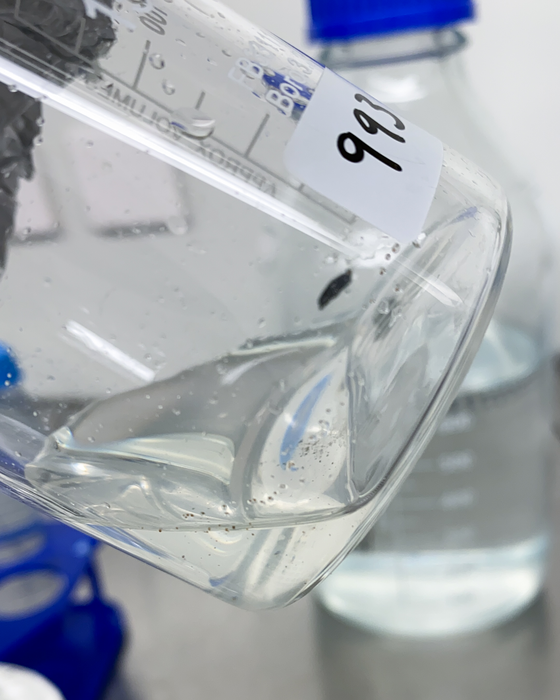Negotiation regarding a new Global Plastics Treaty has made the nations meet in Uruguay. Marine and forensic scientists reported new outcomes this week that disclose the breakthrough of synthetic plastic fibers in seawater, air, sea ice, and sediment sampled in the Antarctic Weddell Sea.

Density separation process during microplastics analysis of samples from Weddell Sea Expedition (c) Nekton. Image Credit: Nekton.
The field study was initiated during an expedition to find Sir Ernest Shackleton’s ship, the Endurance. The study outcome is reported in the journal Frontiers in Marine Science.
In all samples, fibrous polyesters, mainly from textiles, were discovered. Most of the microplastic fibers determined were discovered in the Antarctic air samples, indicating that seabirds and Antarctic animals could be breathing them.
The issue of microplastic fibers is also an airborne problem reaching even the last remaining pristine environments on our planet.
Professor Lucy Woodall, Study Co-Author and Nekton Principal Scientist, University of Oxford
Woodall added, “‘Synthetic fibers are the most prevalent form of microplastic pollution globally and tackling this issue must be at the heart of the Plastic Treaty negotiations.’
Professor Woodall was the first to disclose the existence of plastic in the deep sea in 2014.
A modeling analysis of air trajectories disclosed that areas with greater numbers of fibers were linked to winds coming from southern South America.
The breakthrough discloses that the Antarctic Circumpolar Current and the linked polar front are not serving as an impenetrable barrier that would have avoided the entry of microplastics into the Antarctic region—as believed earlier.
“Ocean currents and winds are the vectors for plastic pollution to travel across the globe and even to the remotest corners of the world. The transboundary nature of microplastics pollution provides more evidence for the urgency and importance of a strong international plastic pollution treaty,” shared Nuria Rico Seijo, Nekton Research Scientist, Oxford, the co-lead author of the research.
Furthermore, the concentration of microplastics was found by the team to be significantly higher in sea ice compared to other sample types. Study indicates that microplastics are being trapped at the time of the making of the sea-ice layer annually.
Sea ice is mobile, can travel vast distances and reach the permanent ice shelves of the Antarctica continent where it can be trapped indefinitely with its gathered microplastic pollutants.
Dr Mánus Cunningham, Study Co-Lead Author and Nekton Research Scientist, University of Oxford
Cunningham added, “We believe the acquisition of microplastics in the multi-year sea ice combined with its seasonal changes could also be considered a temporary sink and one of the main transporters of microplastics within the Antarctic region.”
Also, a broad study was performed on sediment samples that have been recovered at depths varying from 323 to 530 m below the sea’s surface at the time of the Weddell Sea Expedition.
Our discovery of microplastics in seabed sediment samples has revealed evidence of a plastic sink in the depths of the Antarctic waters. Yet again we have seen that plastic pollution is being transported great distances by wind, ice, and sea currents. The results of our research collectively demonstrate the vital importance of reducing plastic pollution globally.
Lucy Woodall, Study Co-Author and Professor, University of Oxford
The scientific and forensic experts at Nekton’s Oxford University and collaborating laboratories (Staffordshire University, Nelson Mandela University, and the University of Cape Town) utilized a range of investigative techniques to examine the samples in the study.
These include chemical (Raman Spectrometry), optical (Polarized Light Microscopy), investigative technologies and even a specialist adhesive called “crime scene” tape for the polymer type to be determined. The modeling analysis used a technique known as Air Mass Back Trajectory analysis.
Gwinnett stated, “Our use of forensic science approaches had two important benefits; improved methods for both the reduction and monitoring of possible procedural contamination in the samples, and also more detailed characterization of the microplastics, beyond just polymer type, allowing for better understanding of the number of possible sources.”
“We would encourage future studies to harness these forensic approaches to ensure more robust data is gathered,” said Professor Claire Gwinnett of Staffordshire University.
According to the research group, the outcomes add an emergency for binding a worldwide agreed treaty to avoid microplastics from entering the environment, especially oceans. In front of the Global Plastic Treaty discussions, they call on policymakers to:
- Decrease plastic pollution and production throughout the world by making a strong global plastics treaty that builds on national and regional initiatives;
- Plastic reduction actions can be aligned with natural and societal targets to obtain several positive results for society;
- It is possible to empower local communities to co-develop and utilize programs that assist in complete life-cycle solutions to plastic waste management.
Also, they add that concerned individuals can play their part by using easy lifestyle habits to decrease synthetic microfiber pollution. These include:
- Fill the washing machine: more space to move around in the wash results in microfibers falling off.
- Ditch the dryer: tumble dryers produce around 40 times more microfibers compared to washing machines.
- Wash at 30 °C: gentle cycles and lower temperatures reduce microfiber shedding.
- Microfiber capture for washing machines, for example, GuppyFriend or Coraball.
- Wash textiles less
- Natural fibers can be chosen, such as organic natural fibers like hemp, linen, and cotton.
- Avoid microfiber cleaning cloths-utilize natural alternatives
Journal Reference:
Cunningham, E. M., et al. (2022) The transport and fate of microplastic fibers in the Antarctic: The role of multiple global processes. Frontiers in Marine Science. doi.org/10.3389/fmars.2022.1056081.